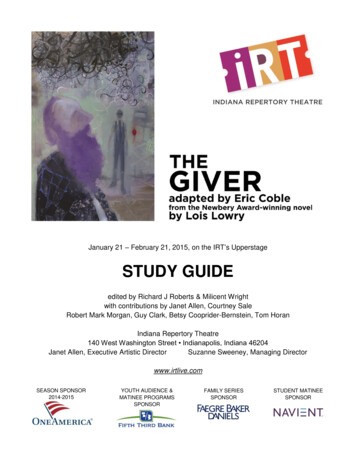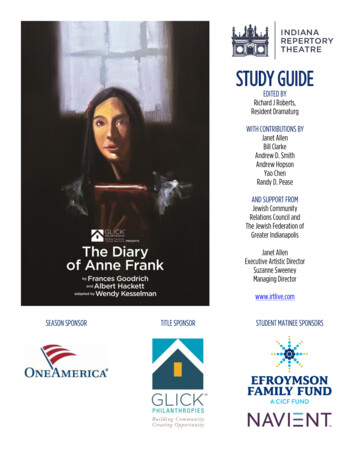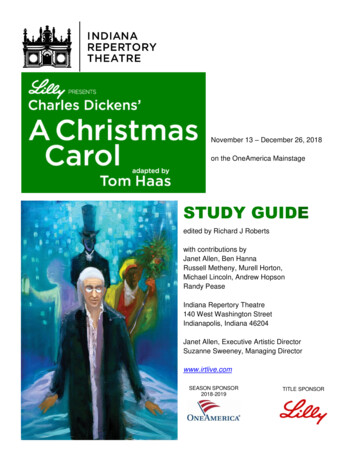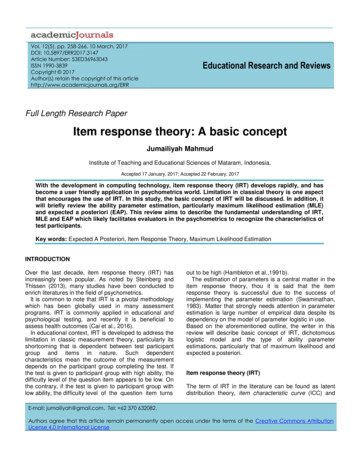
Transcription
January 21 – February 21, 2015, on the IRT’s UpperstageSTUDY GUIDEedited by Richard J Roberts & Milicent Wrightwith contributions by Janet Allen, Courtney SaleRobert Mark Morgan, Guy Clark, Betsy Cooprider-Bernstein, Tom HoranIndiana Repertory Theatre140 West Washington Street Indianapolis, Indiana 46204Janet Allen, Executive Artistic DirectorSuzanne Sweeney, Managing Directorwww.irtlive.comSEASON SPONSOR2014-2015YOUTH AUDIENCE &MATINEE PROGRAMSSPONSORFAMILY SERIESSPONSORSTUDENT MATINEESPONSOR
2 INDIANA REPERTORY THEATREThe Giveradapted by Eric Coblefrom the Newbery Award–winning novel by Lois LowryNo pain. No desire. No choice. Sameness reigns in a utopian society set in the not-too-distantfuture. But for twelve-year-old Jonas, his controlled and predictable life is unraveling before hiseyes. Based on the award-winning book by Lois Lowry, this complex and controversial storyforces us all to question the dangers of conformity and complete safety from all pain. Afterlearning the truth and feeling pain and joy, Jonas realizes he wants to experience all of life andmust leave the safety and security of home.Estimated length: 90 minutesRecommended for students in grades 5 through12THEMES, ISSUES, & TOPICSUtopia/DystopiaSafety and Security vs. FreedomLife of the Community vs. Life of the IndividualStudent Matinees at 9:45 & 11:50 am: Monday-Friday, January 21–February 20ContentsSynopsisArtistic Director’s NoteDirector’s NoteDesigner NotesThe Card CatalogMeet the CharactersAbout The GiverAuthor Lois LowryQuestions, Writing Prompts, & ActivitiesResourcesGlossaryWorks of Art - Kyle RagsdaleGoing to the Theatre34568912141620222324Education SalesRandy Pease 317-916-4842rpease@irtlive.comPat Bebee 317-916-4841pbebee@irtlive.comOutreach ProgramsMilicent Wright 317-916-4843mwright@irtlive.com
INDIANA REPERTORY THEATRE3The StoryJonas lives with his parents and his younger sister, Lily, in a world without hunger, violence, orconflict. Everything in the community is carefully designed for serenity and comfort. Eachfamily unit has two parents and no more than two children; old people are cared for in aseparate facility; appropriate careers are assigned by a committee of elders who carefullyassess each person’s abilities.As the time nears for theannual Ceremony of 12, Jonasand his friends Asher andFiona look forward to receivingtheir life assignments. Jonas issurprised to be singled out asthe community’s Receiver ofMemory. Every day he is toreport to the Giver, an Elderwho holds a special place ofhonor in the community. TheGiver begins to share withJonas the wealth of memoriesand knowledge he carries, andJonas starts to glimpse a worldbeyond the confines of hiscommunity, beyond the hereand now. As he learns aboutthe choices that are no longeravailable to him—or to anyoneelse—Jonas begins toquestion the price thecommunity pays for its placidexistence.
4 INDIANA REPERTORY THEATREListening to Our Youthby Janet Allen, Executive Artistic DirectorIn young adult fiction today, there is a clearfascination with the concept of a dystopian future.The Divergent series, the Hunger Games series,among others, imagine a world not so unlike ours,but where the stakes for human life have beenaltered by cruel survivalist governments. LoisLowry’s The Giver was among the first of this genre: written in 1993, it sold 10 million copiesand won the Newbery Medal for Children’s literature in 1994. It has gone on to become astaple of junior high reading curricula, as it poses an excellent study of the power of theindividual human spirit to act for good in the face of inhuman controls.Among the concerns that this profusion of dystopian novels suggests is that the future appearsto hold some scary possibilities: individual freedoms curtailed, human history obliterated,questioning eliminated, biological families separated, all for the good of the body politic. Amongthe most challenging questions The Giver poses is, “would it really take the elimination ofhuman choice to create a world free of poverty and war?” We all agree that poverty and warare blights on human existence, and certainly Lowry isn’t suggesting that these are human illsworth abiding. Instead, the values raised in her cautionary tale suggest that we must act wiselyand compassionately to honor human individuality, to understand human differences withoutattempting to obliterate them, even if the goal in doing so appears to favor the majority. This isa running theme in dystopian literature, as well as a values system that tweens, teens, andyoung adults are attempting to master: What is the price of conformity and how do individualfreedoms need to dovetail into the fabric of human society? Where does the self leave off andthe health of a social unit of friends, family, school, or workplace prevail? How is socialcompromise achieved without demeaning human life?The zeal to adapt Lowry’s tale to the stage, screen, and even opera house has been veryapparent of late. Jeff Bridges’s film version that premiered this past summer had some braveacting in it; but the ways in which the movie’s creators chose to generalize the book’s contentlessened its impact and moved it away from the coming-of-age story that is so important toLowry’s premise. Eric Coble’s stage adaptation hews closely to Lowry’s story structure andrests firmly on the wide-eyed wonder of the adolescent Jonas as he moves into an adult worldand is expected to accept some decidedly cynical adult reasoning. This stage adaptationcelebrates Lowry’s belief that it takes a child to recognize the pathway out of the rationalizeddysfunction of the adult world, even if it means leaving all that is familiar and safe behind. Nowonder young people celebrate these works: they are a clarion call for clear-eyed empathyand human-centered values. We should all be listening.
INDIANA REPERTORY THEATRE5Lessons in Disobedienceby Courtney Sale, DirectorScan any parenting section at a local bookstore, and you will find scads of literature dedicatedto raising the well-behaved and obedient child. These books reinforce a perceived notion thatsuccess for both caregivers and children springs from a willingness to go along with the pack,make little disturbance, and conform. Americans prize individualism and yet we see thisconformity play out in our homes, our religious institutions, and perhaps most frighteningly inour schools.This past October in Jefferson County, Colorado, school board members proposed a newcurriculum for public school history courses. The proposal suggests educators should notteach works that encourage civil disorder, social strife, or disregard for the law. In this scenariostudents would be “guarded” from the works of Thoreau, the Women’s Suffrage and CivilRights movements, and the Boston Tea Party. How did young people of Jefferson Countyrespond? They staged acts of civil disobedience, participated in walkouts, and voiced theirconcerns in public forums. The proposal marginally passed and debates continue in JeffersonCounty.The Giver offers us a dynamic lesson in disobedience that continues to be strikingly relevant.In Jonas, we find a young man who has little reason to challenge his surroundings. For him,every need is met, every desire numbed. Lois Lowry’s remarkable story reminds us at everyage that when equipped with truth, knowledge, and memory, we must stand up to the mostdisguised oppressors, whether they are familial or foreign. And often the best and mostpowerful tool in that fight is our own disobedience.
6 INDIANA REPERTORY THEATREThe Community and BeyondRobert Mark Morgan Scenic DesignerWhat I believe makes theatre special is that it is a collaborative art form. From the earliest ofdesign meetings moving forward, no member of the creative team can claim one idea oranother as exclusively his or hers. Instead, ideas build upon ideas into one marvelous creativestack of . file drawers.Led by our director, Courtney Sale, design meetings for The Giver were emblematic of thisapproach. We launched ourselves into discussions of how we categorize and organizememories, thoughts, and significant events in our lives both on an internal or subconsciouslevel, but also an external one. Remember card catalogs? Remember microfiche? Even beforeknowing what the set would be, we referenced it as a “sculpture” that would serve as ametaphor for this physical and mental categorization of memories as well as (of course) ascenic “device” for staging the play. The result sits before you now. I hope you enjoy thememory you create tonight and carry with you . in whatever way you store it.Preliminary scenic drawing by designer Robert Mark Morgan.
INDIANA REPERTORY THEATRE7Betsy Cooprider-Bernstein Lighting DesignerI am excited to light my second production of The Giver at the IRT because this cautionary taleis so compelling. I am a big fan of this genre and I know the impact it can have on ouraudiences. As I approach this production, I envision a world of high contrasts. At first we seean environment controlled by “sameness”—which does not necessarily mean bland andboring. Perhaps it looks like a place we would like to be: safe, calm, serene. But then we beginto see the world differently, affected by what we learn from the Giver. The memories he shareswith Jonas invoke images of color, texture, shape, and movement. Theatrical lighting will usethese same qualities to enrich and enliven the play’s revelations.Guy Clark Costume DesignerA lack of choices does not have to leadto an environment of stark privation.Imagine an all-expense-paid vacation ona luxury cruise liner where your everyneed is lavishly met. Everything aroundyou is designed to remove all worries—until the morning you wake up cravingsomething not on the menu.Costume renderingsfor Jonas and the Giverby designer Guy Clark.Tom Horan Sound DesignerI first read The Giver just after it was published, and I’ve enjoyed helping to bring to life a novelthat has been so influential to current Young Adult literature. In tackling the sound design forthis show, I began to see Jonas’s music-less world as an extension of our own—how on anygiven day we are more likely to hear a ringtone than someone actually playing an instrument.What do we lose when we no longer hear the creak of fingers against steel strings of a guitar,or the breath of the singer? Are we okay with music that is merely pleasant? How often havewe been on the phone with a soothing computer voice rather than a person? It is possible,however, to restore what has been lost. The memories that serve Jonas’s journey are madevisceral—and therefore more real—by their complicated and dissonant sound.
8 INDIANA REPERTORY THEATREThe Card CatalogEarly librarians kept written lists, orcatalogs, of their holdings, organizedas each librarian saw fit. Newacquisitions had to be squeezed intothe margins until a new, reorganizedlist was created. The first card catalogsappeared in the 1800s after thestandardization of the 3x5 card forpersonal filing systems. Each cardlisted author, title, subject, date ofpublication, publisher, etc. Three cardsmight be created for each book in thelibrary, to be filed by author, title, or subject, enabling greater flexibility in searching. Updateswere easily accomplished by filing new cards between old ones. The cards were filed in small,deep drawers that might be pulled out and set on a table for easier access. Library patronsflipped through the cards to find what books the library held by a given author, or on a givensubject. Online cataloging was first developed in 1983 and widely used by the late 1990s.Although card catalogs are rarely seen today, they are still part of our collective memory: afamiliar sight to generations of library users, and an apt metaphor for organizing ideas.
INDIANA REPERTORY THEATREMeet the CharactersJonasplayed by Grayson MolinAs the play begins, Jonas is unsure whatassignment he will receive from the Council ofElders. When he becomes the community’sReceiver of Memory, he discovers that theflashes of Beyond he has glimpsed are a raregift that will take him to places he neverimagined.The Giverplayed by David Alan AndersonThe community’s long-time Receiver ofMemory has held the community’s collectivememory for many years. He uses thisknowledge to help the Council of Eldersmake important decisions.Costumedrawingsby designerGuy Clark.9
10 INDIANA REPERTORY THEATREThis actor plays two different characters.Chief Elderplayed by Katie deBuysAs leader of thecommunity’s Council ofElders, the Chief Elderannounces young people’sassignments at theCeremony of Twelve.Motherplayed by Katie deBuysJonas’s mother holds animportant position in thecommunity’s Department ofJustice, ensuring that thecitizens of the communityfollow the rules.Fatherplayed by Bill SimmonsJonas’s father is a Nurturerwho cares for thecommunity’s newchildren,helping to meet theirphysical and emotionalneeds.
INDIANA REPERTORY THEATREFionaplayed by Lola KennedyFiona is a sensitive, thoughtfulfriend of Jonas who loves tovolunteer as a Caretaker in theHouse of the Old.Asherplayed by Joseph HockAnother friend of Jonas,Asher has a playful naturethat makes him ideal for hisassignment as AssistantDirector of Recreation.11Lilyplayed by Jordan PecarLily is Jonas’s younger sister.Like many seven-year-olds,she can be impatient and abit of a chatterbox.
12 INDIANA REPERTORY THEATRE“an Elsewherefrom which it came”The Giver is a novel by Lois Lowry, who has writtenmore than 30 books for children. Two of her novelshave won the prestigious Newbery Medal for distinguished contributions to American literature forchildren: Number the Stars (1990), a work ofhistorical fiction about the Holocaust, and The Giver(1994). Lowry is known for offering young readersthe opportunity to confront challenging subject matter, including racism, terminal illness, and death.Although her novels are not autobiographical, like most authors Lowry has incorporated herown life experiences into her works in different ways. In her 1994 speech accepting theNewbery Medal for The Giver, she discussed how certain elements of the book may havebeen inspired by various experiences in her life. She referred to a passage from the book inwhich Jonas begins to look more deeply into his own life as he learns of a past that he neverknew existed:“. Now he saw the familiar wide river beside the path differently. He saw all of the light andcolor and history it contained and carried in its slow-moving water; and he knew that there wasan Elsewhere from which it came, and an Elsewhere to which it was going.”Lois Lowry’s father was an Army dentist. From the age of 11 to 13,Lois lived in Tokyo, Japan, in a small, enclosed community ofAmericans. As foreigners in a strange land, her family found thefamiliarity of this self-contained environment comfortable and safe.But young Lois was intrigued by the exotic sights and sounds andsmells of the surrounding city. She would sneak away and ride herbicycle through the busy streets filled with noisy street vendorsand bright colors and strange music. Perhaps these experiencescontributed to the creation of Jonas’s quiet, safe community andits perception of the world beyond.Lois Lowry at age 12,wearing a traditional Japanese kimono .
INDIANA REPERTORY THEATRE13In 1979 Lowry interviewed the painterCarl Nelson, and she was taken withthe artist’s vivid capacity forunderstanding and appreciating color.Years later, when she learned that hehad become blind, she wonderedwhat it was like for him to lose thecolors about which he was soimpassioned. It may be that thisexperience was the seed for creatinga world without color in The Giver.Lowry’s own photograph of Nelson isthe face on the cover of most editionsof the novel (seen at right).Dealing with her own aged father’sloss of memory may have causedLowry to wonder about a world withno memories. The author’s ownmemories include how she and hercollege friends had shunned a girlwho was different. What did Lowrymiss by not being that girl’s friend, bynot appreciating and even celebratingdifferences? Such thoughts may havesuggested the sacrifices necessary tocreate a world without differences, a world of sameness. Attending her son’s wedding inGermany and thinking of the union of good wishes expressed in the confusion of differentlanguages may have inspired the author to think of the interconnectedness of all people.Lois Lowry has often been criticized for her subject material. Should children be exposed tosuch topics? Is it safe? In her 1994 Newbery Medal speech, the author addressed this issue:“. I remember once again how comfortable, familiar, and safe my parents had sought to makemy childhood by shielding me from Elsewhere. But I remember, too, that my response hadbeen to open the gate again and again. My instinct had been a child’s attempt to see for myselfwhat lay beyond the wall.“The man that I named the Giver passed along to the boy knowledge, history, memories, color,pain, laughter, love, and truth. Every time you place a book in the hands of a child, you do thesame thing. It is very risky. But each time a child opens a book, he pushes open the gate thatseparates him from Elsewhere. It gives him choices. It gives him freedom.”
14 INDIANA REPERTORY THEATREAuthor Lois LowryLois Lowry is a prize-winning author of morethan 30 books for children. Born LoisHammersberg in Honolulu, Hawaii, in 1937,she was the daughter of an Army dentist, andher family moved frequently. Lois grew up inCarlisle, Pennsylvania; Tokyo, Japan; andNew York City. She has written, “From thetime I was eight or nine, I wanted to be awriter. Writing was what I liked best in school;it was what I did best in school.“I was a solitary child, born the middle ofthree, who lived in the world of books and myown imagination. There are some children,and I was this kind of child, who are introvertsand love to read—who prefer to curl up with abook than to hang out with friends or play atthe ball field. Children like that begin todevelop a feeling for language and for story.And that was true for me—that’s how I becamea writer.”Lois Lowry (left) at age 4,with her 7-year-old sister Helen, 1941.After studying for two years at Brown University, Lois married Donald Lowry, a Navy officer,and found herself once again on the move. The couple (and eventually their four children) livedin California, Connecticut, Florida, South Carolina, Massachusetts, and Maine, where theyfinally settled after Donald left the Navy and became a lawyer. As her children grew, Lowryfound time to return to school at the University of Maine, earning her B.A. in English literatureand then pursuing graduate studies.Lowry’s work as a freelance journalist and photographer caught the attention of an editor atHoughton Mifflin Publishing, who suggested she write a children’s book. A Summer to Die is afictionalized account of the early death of Lowry’s sister. The book was published in 1977, thesame year Lowry and her husband divorced.“My books have varied in content and in style,” says Lowry. “Yet it seems to me that all of themdeal, essentially, with the same general theme: the importance of human connections.”Number the Stars, winner of the Newbery Medal in 1990, is a work of historical fiction aboutthe Holocaust. In the book, ten-year-old Annemarie and her family risk their lives to protectAnnemarie’s Jewish best friend.
INDIANA REPERTORY THEATRE15Lowry was awarded a second Newbery Medal in 1994 for The Giver, which the author says isabout “the vital need for humans to be aware of their interdependence, not only with eachother, but with the world and its environment.” Subsequently she has written three relatedbooks, creating a tetralogy. Gathering Blue (2000) tells the story of Kira, an orphaned girl witha twisted leg in a society that chooses to leave the disabled exposed to die in the fields.Messenger (2004) features characters from both previous novels and ties them to the story ofMatty, who delivers messages through the dark forest surrounding his village. Son (2012)follows the story of Claire, birth mother of Gabriel from The Giver.Lowry’s other works include a series of nine novels about Anastasia Krupnik—a girl “just tryingto grow up”—and four novels about Anastasia’s younger brother Sam. “I use the Anastasiabooks to make myself laugh and to lighten up between serious books,” says the author. “But Ialso use them to deal with serious topics in a different way, disguised by humor.” Lowry’s morerecent Gooney Bird series focuses on creativity and story-telling.“I think it is my own children, all of them grown now, who have caused me to expand my view,”says Lowry. “One of my sons was a fighter pilot in the United States Air Force; as a motherduring the Gulf War, I was newly stunned into fear for the world and a heightened awarenessof the necessity to find a way to end conflict. One of my daughters has become disabled as aresult of a disease of the central nervous system; through her, I have a new and passionateawareness of the importance of human connections that transcend physical differences.”And I have grandchildren now. For them I feel a greater urgency to do what I can to conveythe knowledge that we live intertwined on this planet, and that our future as human beingsdepends upon our caring more, and doing more, for one another.”
16 INDIANA REPERTORY THEATREDiscussion QuestionsBefore seeing the play:Discuss other plays, movies, operas, or ballets you have seen that are adaptations of booksyou have read. What did you like or dislike about those performed adaptations? What wouldyou have done differently in your adaptation?Go online and read about other productions of this play in other cities. Remember to use theplaywright’s name when doing your search. What can you find out about other plays Eric Coblehas written? What did reviewers say about other productions of this play? After seeing theIRT’s production, write your own review.After seeing the play:What do the words utopia and dystopia mean? Should humans strive to create a perfectsociety? Why or why not? Can perfection be achieved? Discuss the flaws in Jonas’scommunity. When and how does a utopia become dystopia?Discuss whether we live in a world that celebrates sameness or differences. During yourdiscussion, factor in the past and the present, theory and reality, industrial nations and thirdworld countries.What is a rite of passage? What are some typical rites of passage? With each rite of passage,what do you believe you gain or lose? In what ways have rites of passage changed fromgeneration to generation?The hero in The Giver is a 12-year-old boy, a reminder that children are capable of achievinggreat feats and motivating change. In groups discuss other young literary heroes. What makesthese characters so appealing? What lessons can we take away from their stories? Namesome real-life boys and girls who have made a difference in their local and nationalcommunities. What inner qualities make a person become a hero?In the play the Giver says to Jonas, “I have great honor. So will you. But you will find that thatis not the same as power.” What does this statement mean? Is either power or honor betterthan the other? There are many famous people (actors, musicians, dancers, athletes,celebrities) who might be said to have great honor. How have different people used such honorto wield power—to influence the world (in good or bad ways)?
INDIANA REPERTORY THEATRE17Art often imitates life. Sometimes life imitates art. What in The Giver captures a true picture ofyour life? Consider such things as family, friendships, education, professions, socialcourtesies, and attitudes. What in The Giver is different from your life? What can we learn fromboth the similarities and the differences?What happens to Jonas and Gabe at the end of the story? What is “Elsewhere”?How did what you saw on stage compare to the image you created in your mind when youread the book? Was the storytelling clear, compelling, and entertaining? Why or why not?Have you read Lois Lowry’s original book, The Giver? Have you seen the recent film?Compare and contrast the book, the film, and the play. In what areas was one version moreeffective than the others? In what areas was each less effective? Which did you feel told thestory in the most compelling way? Why?In this story there is a clear system for messaging. In our world who controls the messages wereceive? How does this influence us as individuals and as a society?In life we all have to make choices, what is the cost of the choices you make?ActivitiesBefore seeing the play:If you have read the book The Giver, try imagining how parts of the story might be presentedon the stage. In class or with friends, assemble a director and a design team—scenery,costume, lighting, and sound designers—and create your own “look” for the play. Take asection of the story that you all enjoyed the most, draw it, stage it, and present your concept tothe class or your parents.Research the process of adaptation. What steps does a writer go through to create his or herown work based on another person’s work? Is the original work in public domain? What is acopyright? How do you obtain the rights? How do you submit your work to publishers of plays?Where can you go for new play development?
18 INDIANA REPERTORY THEATREActivitiesAfter seeing the play:Although The Giver has been chosen by many school systems to be part of the curriculum, ithas also been challenged. Find more on banned books and intellectual freedom /censorshipfirstamendmentissues/index.cfm.Imagine that your rights to read the book and/or to see the play were being challenged.Prepare a defense for The Giver and present your case to your class. This article athttp://www.ala.org/ala/newspresscenter/news/ pressreleases2007/january2007/edwards07.cfmoffers information that may be useful in your presentation. Why is it important that citizenshave the right to challenge books they feel are inappropriate? Why is it important for those whodisagree with that opinion to speak up in defense of such books?What is civil disobedience? How do the choices of Jonas and the Giver relate to this concept?What has the world gained and lost from dissension? Research famous dissenters of the pastand present. How have their actions been a force for improvement and/or destruction in theworld?Improvisation: “Dreams and Nightmares” Divide into groups of four to five people. Each personshares a dream or nightmare; then each group chooses one to dramatize. Cast the characters,decide on props or use pantomime, rehearse, and perform. This exercise is more fun usingimagery and metaphor. Example: Instead of someone saying, “I am hungry,” you might havean actor who plays talking food; or a character might say, “Oh no, I’m a hotdog with chilisauce!”In The Giver, Asher struggles with word usage in a community that attempts to be very precisewith language. As a group, make a list of commonly misused words and phrases. Do someresearch on the subject. There are hundreds of books and websites. Here are a few just to getyou .htmhttp://en.wikipedia.org/wiki/List of commonly mis-used English wordsNew York Times Dictionary of Misunderstood, Misused, & Mispronounced Wordsby Laurence Urdang100 Words Almost Everyone Confuses and Misuses (The 100 Words)by Editors of the American Heritage Dictionaries
INDIANA REPERTORY THEATRE19Writing PromptsWhat are people willing to give up in the search for security? What are people willing to give upin the search for freedom? Cite cultural, historical, and personal examples.How you would feel if you discovered that someone or something important in your life wasn’twhat you thought it was. What would happen if your perception of your life was shattered?Are memories important to your family? Who is the memory keeper in your family? Why is thisperson the keeper of your family’s memory? How and when does this person share thosememories? Who in your family do you believe is the receiver?Along with The Giver, the IRT has produced a number of plays that are adaptations of popularliterary works such as The Velveteen Rabbit, A Christmas Carol, Who Am I This Time?, AnIliad, Dr. Jekyll and Mr. Hyde, Dracula, and later this season The Hound of the Baskervilles.Think about a novel or short story that you have read lately and tell us why you believe it wouldbe good to adapt into a play. Share with us the major messages of the story that would beappealing to a diverse audience. Share with us how you might present the production. Choosea favorite part of the book and write your own stage adaptation of that section.In The Giver, each person is assigned a career based on the evaluation of an outsidecommittee. Write a poem on the theme of what others see in you versus how you see yourself.An actor builds his or her character from three things: what the character says; what thecharacter does; what others say about the character. Often, an actor will create an innermonologue to fill out a moment. Select a character and write an inner monologue for one of hisor her high emotional moments. For example: What is Fiona thinking after she gets herassignment as Caretaker for the Old? What is Jonas feeling when his name is skipped duringthe Ceremony of Twelve?Write a review of the play. What moments made an impression on you? How do the elementsof scenery, costumes, lighting, and sound work with the actors’ performance of the text to tellthe story? What ideas or themes did the play make you think about? How did it make you feel?To share your reviews with others, send to: education.irt@gmail.com
20 INDIANA REPERTORY THEATREResourcesBooks:For Younger Readers:Gossamer by Lois LowryA Wrinkle in Time by Madeleine L’Engle
eyes. Based on the award-winning book by Lois Lowry, this complex and controversial story forces us all to question the dangers of conformity and complete safety from all pain. After learning the truth and feeling pain and joy, Jonas realizes he wants to experience al










